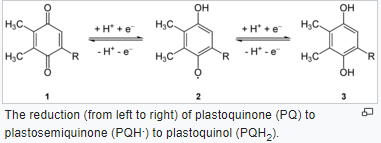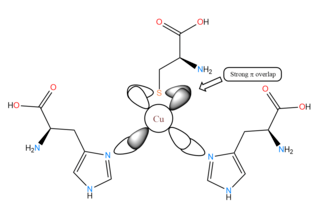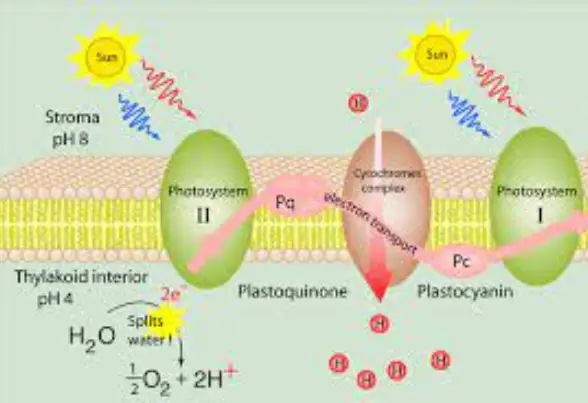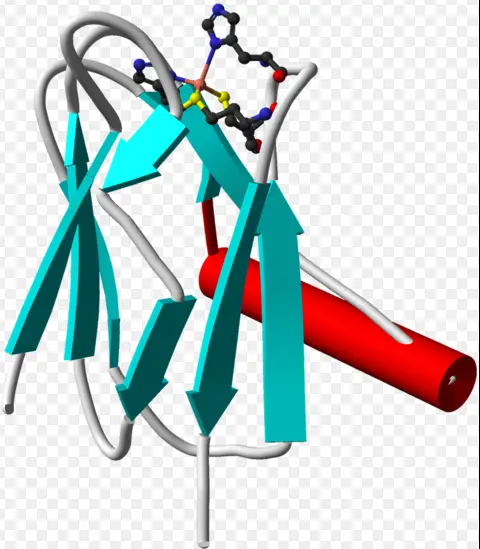Photosynthesis is a vital process that sustains plant life and, by extension, nearly all life on Earth. Central to this process are various molecules that facilitate the transfer of electrons during the light-dependent reactions. Among these, plastoquinone and plastocyanin play crucial roles, though they differ significantly in their functions and properties.
Plastoquinone and plastocyanin are both involved in the electron transport chain of photosynthesis, but they serve distinct roles. Plastoquinone acts primarily as an electron shuttle within the photosystem II complex, facilitating the transfer of electrons from water to the cytochrome b6f complex. Plastocyanin, on the other hand, transfers electrons from the cytochrome complex to photosystem I. These differing roles underscore the unique characteristics and crucial functions they perform in photosynthesis.
Understanding the chemical structure and behavior of these molecules within the chloroplast highlights their essential roles in energy capture and conversion. Their activities not only impact the efficiency of photosynthesis but also influence broader ecological and biological processes, offering insights into plant health and productivity.

Plastoquinone Explained
Chemical Structure
Plastoquinone is a type of quinone molecule characterized by a benzene ring with two ketone substitutions. It is a small, lipid-soluble molecule that plays an essential role as an electron carrier in the electron transport chain of photosynthesis. The chemical formula of plastoquinone, generally referred to as PQ, includes a long isoprenoid side chain, which makes it highly lipid-soluble and allows it to operate within the phospholipid bilayer of chloroplast membranes.
Role in Photosynthesis
In the light-dependent reactions of photosynthesis, plastoquinone functions as an electron transporter between two major protein complexes within the thylakoid membrane. After photons hit the photosystem II (PSII), they energize electrons to a higher energy state. Plastoquinone collects these energized electrons and transfers them to the next complex in the chain, the cytochrome b6f complex. This electron transfer is crucial for maintaining the flow of electrons that drives the synthesis of ATP and NADPH, which are vital for the light-independent reactions.
- Electron Acceptance: Plastoquinone accepts electrons from the PSII reaction center.
- Proton Gradient: As it transports electrons, it also moves protons across the thylakoid membrane, helping to generate a proton gradient used by ATP synthase.
Location in the Chloroplast
Plastoquinone is located within the thylakoid membranes of the chloroplast, the site of the light-dependent reactions of photosynthesis. Its lipid-soluble nature allows it to diffuse rapidly within the hydrophobic core of the thylakoid membrane, efficiently connecting the complexes involved in electron transport.
Plastocyanin Overview
Chemical Composition
Plastocyanin is a small copper protein found in the thylakoid lumen of chloroplasts. Unlike plastoquinone, plastocyanin is water-soluble and contains a copper ion that plays a direct role in its ability to transfer electrons. This blue copper protein is crucial for its function as it cycles between oxidized and reduced states, accepting and donating electrons during the process.
Function in Photosynthesis
The primary role of plastocyanin is to transfer electrons from the cytochrome b6f complex to photosystem I (PSI). This transfer is vital for the continuation of the electron flow towards the reduction of NADP+ to NADPH. The efficient function of plastocyanin ensures that the light-dependent reactions proceed smoothly, supporting the plant’s ability to synthesize organic molecules.
- Electron Donation: Plastocyanin donates electrons directly to PSI, which is crucial for the reduction of NADP+.
- Facilitation of Energy Capture: Its role is central to maximizing the capture of solar energy in the form of chemical energy.
Location and Movement
Plastocyanin is located in the lumen of the thylakoid membranes, where it moves freely in its water-soluble state. Its mobility allows it to interact efficiently with the cytochrome b6f complex and PSI, facilitating rapid electron transfer across the membrane.
Key Differences
Molecular Structure
The fundamental difference between plastoquinone and plastocyanin lies in their molecular structures. Plastoquinone is a hydrophobic molecule with a quinone core and a long isoprenoid chain, making it ideal for operation within the lipid bilayer. In contrast, plastocyanin is a water-soluble protein that contains a copper ion, necessary for its function as an electron carrier in the aqueous environment of the thylakoid lumen.
Solubility and Mobility
Their solubility plays a critical role in their functions. Plastoquinone’s lipid solubility allows it to move within the membrane freely, while plastocyanin’s water solubility enables it to navigate through the thylakoid lumen. This difference in mobility directly influences how they interact with other components of the electron transport chain.
Specific Roles in the Electron Transport Chain
Plastoquinone and plastocyanin serve specific and non-interchangeable roles in the electron transport chain. Plastoquinone shuttles electrons within the membrane, contributing to the creation of a proton gradient essential for ATP synthesis. On the other hand, plastocyanin transfers electrons across the aqueous lumen to PSI, facilitating the final steps of electron transport necessary for NADPH production. This delineation ensures that electron flow is maintained efficiently and correctly through the sequential components of the light-dependent reactions.

Biological Functions
Impact on Photosynthesis Efficiency
Plastoquinone and plastocyanin are pivotal in determining the overall efficiency of photosynthesis due to their roles in the electron transport chain. The efficiency with which these molecules perform their roles affects the rate at which photons are converted into biochemical energy.
- Energy Conversion: Efficient electron transport facilitated by plastoquinone and plastocyanin ensures maximal conversion of solar energy into chemical energy, which is critical for the growth and health of the plant.
- ATP and NADPH Production: These molecules directly impact the synthesis of ATP and NADPH, crucial energy carriers needed for the Calvin cycle, where CO2 is fixed into glucose.
Interactions with Other Molecules
The interaction between plastoquinone and plastocyanin with other molecules in the chloroplast highlights their central role in the tightly regulated process of photosynthesis.
- Interaction with Photosystem II and I: Plastoquinone receives electrons from photosystem II and passes them to the cytochrome b6f complex, while plastocyanin carries electrons from cytochrome b6f to photosystem I.
- Synergy with Cytochrome Complex: These interactions are crucial for maintaining a steady flow of electrons, essential for sustaining the energy conversion processes.
Practical Applications
Research and Genetic Engineering
Understanding the molecular functions and structures of plastoquinone and plastocyanin has opened up new avenues in genetic engineering, aiming to optimize photosynthesis for agricultural and energy production purposes.
- Enhanced Photosynthetic Traits: Scientists are exploring ways to genetically modify these electron carriers to increase plant tolerance to various stressors such as drought and high light conditions.
- Bioengineering: Efforts to manipulate these molecules could lead to plants with higher yields or plants capable of thriving in sub-optimal growing conditions, thus expanding arable land and reducing resource inputs.
Agricultural Implications
The role of plastoquinone and plastocyanin in photosynthesis has significant implications for agriculture, particularly in how crops are developed and managed to cope with the challenges posed by climate change.
- Crop Efficiency: By enhancing the efficiency of these molecules through breeding or genetic modification, crops can be made more productive and more resistant to environmental stresses.
- Sustainable Practices: Understanding these molecules helps in the development of agricultural strategies that maximize photosynthetic efficiency, leading to less water and fertilizer use and promoting sustainable agricultural practices.

Frequently Asked Questions
What is Plastoquinone?
Plastoquinone is a quinone molecule involved in the electron transport chain in photosynthesis. It acts as an electron carrier, transporting electrons from photosystem II to the cytochrome b6f complex in the chloroplasts of plant cells.
What is Plastocyanin?
Plastocyanin is a copper-containing protein that plays a key role in the electron transport chain, specifically transferring electrons from the cytochrome b6f complex to photosystem I. It is crucial for the continuation of photosynthesis, particularly in the light reactions.
How do Plastoquinone and Plastocyanin differ?
While both are essential to the photosynthetic light reactions, plastoquinone and plastocyanin differ primarily in their structure and specific roles. Plastoquinone is a small, lipid-soluble molecule, whereas plastocyanin is a water-soluble protein. This difference in solubility influences their respective functions and locations within the chloroplast.
Why are Plastoquinone and Plastocyanin important in photosynthesis?
These molecules are critical because they enable the transport of electrons necessary for the synthesis of ATP and NADPH, which are vital for the Calvin cycle and other synthetic processes in plants. Their efficiency directly affects overall photosynthetic productivity and energy conversion in ecosystems.
Conclusion
The roles of plastoquinone and plastocyanin within the photosynthetic apparatus highlight their significance in energy sustainability and ecological balance. By facilitating the smooth progression of electrons through the light-dependent reactions, these molecules ensure that plants efficiently convert solar energy into chemical energy, supporting life on Earth.
Future studies on plastoquinone and plastocyanin could lead to breakthroughs in enhancing photosynthetic efficiency and agricultural productivity. Understanding their mechanisms more deeply may pave the way for bioengineering crops that can withstand the challenges posed by a changing climate, securing food sources for the growing global population.

